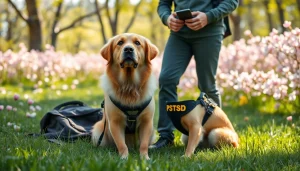The Importance of Service Dog Trainer Qualifications
Understanding Certification and Training Standards
When selecting a service dog trainer, one must take into account the qualifications and certifications that the trainers hold. Certifications often indicate that a trainer has met certain standards set by recognized organizations, which typically encompass a comprehensive understanding of canine behavior, training methodologies, and the specific needs of clients requiring assistance in daily activities. Organizations like Assistance Dogs International (ADI) set rigorous criteria for trainers, thus elevating the overall quality of training provided. A certified trainer is often more likely to employ effective techniques and adhere to ethical practices essential for creating a well-trained service dog.
Evaluating Experience and Specialization
Experience plays a crucial role in a trainer’s ability to effectively train service dogs. It is essential to evaluate the trainer’s background, including how long they have been in the field and the types of service dogs they have trained. Some trainers might specialize in certain types of assistance, ranging from mobility support to psychological support for anxiety or PTSD. Understanding these specializations can help individuals seeking a service dog trainer select someone who is well-versed in meeting their specific needs, leading to a more successful training experience. This nuanced approach to specialization ensures that trainers not only understand canine behavior but also the particular challenges faced by their clients.
Recognizing Ethical Practices in Training
Ethics in dog training cannot be overlooked. Ethical trainers avoid using harsh techniques or punitive measures that can damage the dog-human bond. Instead, they focus on positive reinforcement and rewards, which foster a trusting relationship between the dog and the owner. It is vital to inquire about the trainer’s philosophy regarding dog training. A respected trainer ensures that training is conducted humanely, reinforcing good behaviors without resorting to fear or intimidation, thereby creating a safe learning environment for the dog. The trainer should have a clear plan that promotes welfare and respects the dog’s well-being during the training process.
Common Challenges in Service Dog Training
Addressing Behavioral Issues in Service Dogs
Service dogs, like all dogs, can experience behavioral issues that must be addressed during training. These issues may include distractions during work, anxiety in public settings, or difficulties in understanding commands. Resolving these challenges requires creativity and patience. A qualified service dog trainer can employ various behavioral modification techniques based on positive reinforcement to help the dog overcome these obstacles. For instance, if a service dog is overly distracted by noises in public spaces, the trainer may utilize counter-conditioning techniques that gradually expose the dog to these distractions in a controlled manner, rewarding calm behavior and reinforcing focus on the handler.
Overcoming Human-Dog Communication Barriers
Effective communication between handler and dog is essential for success in training. Often, issues arise when the handler’s expectations or commands are unclear to the dog. Trainers can facilitate this communication by teaching handlers how to give clear, concise, and consistent commands while pairing verbal cues with hand signals or gestures. Moreover, teaching the handler to recognize canine body language can significantly enhance the partnership. This understanding helps handlers interpret their dog’s needs and reactions, leading to a smoother training process and a more effective service dog.
Time Commitment and Consistency in Training
Training a service dog is not a short-term project; it requires time, dedication, and consistency. Beyond the structured sessions with a trainer, daily practice at home is necessary for reinforcing skills and commands. Potential dog owners need to understand that training can take from several months to years, depending on the dog’s individual needs and the complexity of the tasks it must perform. Establishing a consistent schedule for training sessions breeds success and reinforces the skills being learned. This commitment to ongoing training not only improves the dog’s abilities but also strengthens the bond between the dog and handler.
Techniques Utilized by Successful Service Dog Trainers
Positive Reinforcement Strategies
Positive reinforcement is a cornerstone methodology in effective dog training. It involves rewarding desired behaviors rather than punishing undesired actions, making the learning process enjoyable and engaging for the dog. Trainers utilize various rewards—such as treats, praise, or play—to reinforce correct behaviors. Over time, the dog learns to associate obedience with positive outcomes, significantly improving learning and retention. Successful service dog trainers are adept at timing their rewards to ensure that dogs connect the behavior with the reward, further enhancing effectiveness.
Socialization and Public Access Training
A well-rounded service dog must be socialized adequately to behave appropriately in various environments. Trainers often conduct socialization training exercises that expose the dog to different stimuli, including bustling streets, crowded stores, and various human interactions. This training builds the dog’s confidence and teaches it to remain calm and obedient under diverse conditions. Additionally, public access training is critical as it teaches the dog to behave appropriately in spaces where it will accompany its handler, thus ensuring compliance with service dog regulations while promoting a safe atmosphere for everyone.
Tailoring Training to Specific Disabilities
Not every service dog is the same; they can be trained to assist individuals with a wide range of disabilities, such as physical impairments, intellectual disabilities, psychiatric conditions, and medical concerns. It is vital for trainers to tailor their methods based on the type of assistance required. For instance, a dog trained for mobility assistance will have a different skill set than one trained for alerting a person to a medical condition. A successful service dog trainer conducts a thorough assessment of the individual’s needs in order to create a customized training plan that aligns with those needs.
How to Choose the Right Service Dog Trainer for Your Needs
Researching Local Trainers and Programs
Finding the right service dog trainer begins with thorough research. Prospective clients should seek out local trainers who specialize in service dog training and have good reputations. This can involve exploring online reviews, joining community groups, or seeking recommendations from individuals who have successfully trained service dogs. Additionally, many trainers offer informational sessions or workshops that can provide a firsthand look at their training methods and philosophies. This initial research phase is crucial as it helps narrow down the options to those that genuinely align with the individual’s needs.
Assessing Training Styles and Methods
Each trainer may have their unique approach to training, informed by their preferences, philosophies, and past experiences. When evaluating different trainers, potential clients should inquire about their training styles—whether they lean towards positive reinforcement, traditional methods, or a combination. Observing training sessions can provide insights into a trainer’s methodology and the relationship they foster with the dogs. Moreover, understanding the trainer’s adaptability in adjusting their methods based on the dog’s responses and behavior can be indicative of both their expertise and their respect for canine welfare.
Viewing Trainer Testimonials and Case Studies
Testimonials and real-world case studies can be invaluable resources when selecting a service dog trainer. These provide concrete evidence of the trainer’s success and effectiveness. Potential clients should actively seek out feedback from clients who have previously trained with the trainer, focusing on outcomes, the dogs’ behaviors after training, and client satisfaction. Gathering this data can help prospective clients develop a comprehensive understanding of what to expect from the trainer, ensuring they make an informed decision that is in line with their expectations and needs.
Future Trends in Service Dog Training
The Impact of Technology on Training Methods
The integration of technology in dog training is rapidly evolving and holds great potential for enhancing traditional methods. Innovations such as virtual reality, mobile training apps, and online platforms for consultation can provide expanded training options for handlers and trainers alike. For example, virtual reality can simulate different environments for socialization exercises, while apps can help dog owners track their dog’s progress and receive instant feedback on training techniques. As technology continues to emerge, trainers who embrace these tools will likely have a competitive edge, improving the overall training experience.
Emerging Research in Canine Behavior
Scientific advancements in understanding canine behavior are influencing training methodologies. Key areas of research are examining how dogs learn, react to training cues, and bond with their handlers. Stay updated on current studies will allow trainers to refine their techniques continuously, leveraging evidence-based practices to enhance learning experiences. Professionals in the field may benefit from participating in ongoing education workshops and incorporating the latest findings into their training programs, resulting in more effective service dog teams.
Community Resources Supporting Service Dog Training
Communities increasingly recognize the value of service dogs and are enhancing resources available to trainers and handlers. From local support groups to government initiatives, support networks are developing in order to create a robust environment for both trainers and individuals in need. Organizations may provide educational materials, financial assistance, and access to training facilities. Engaging with community resources not only enriches the training process but also helps to create a supportive network of individuals who understand the intricacies of service dog training.


